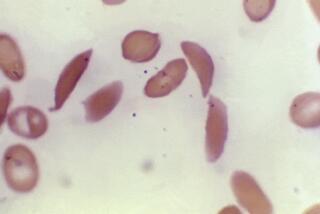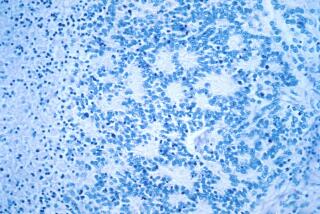Setback in Research Fight Against MD
- Share via
COLUMBUS, Ohio — Last year, Donovan Decker became the first recipient of a gene therapy injection to test the safety of a possible treatment for muscular dystrophy. Now he’s worried his cure won’t come soon enough.
The experiment ended abruptly after the death of a teenager who received a different gene therapy treatment.
Decker, of Huron, S.D., suffers from limb-girdle muscular dystrophy, a disease that mostly damages muscles that stabilize the hips and shoulders. The 36-year-old air traffic controller cannot walk long distances, and his condition is worsening.
Researchers at Ohio State University Medical Center, in conjunction with the University of Pennsylvania, injected the therapeutic gene into a muscle on the top of Decker’s foot on Sept. 3, 1999. The injection contained a cold virus modified to carry genes for a muscle protein Decker was missing because of a genetic flaw.
The injection was sufficient only to test the procedure, not to improve Decker’s health. Doctors warned that the procedure could worsen his condition and put him in a wheelchair earlier than expected, Decker said, but he recalls feeling happy and hopeful at taking some action.
“If nothing is done I am pretty much going to be in a wheelchair in three years anyway,” Decker said.
Adding to Decker’s urgency, four of his seven siblings have the disease. His only sister without it has two daughters with MD.
“A couple of my sisters are in wheelchairs all the time,” he said.
Decker’s mother, Ruth Weber, found out 21 years ago that five of her children have MD.
“It was very traumatic. You have your hopes and dreams for your kids and I thought they wouldn’t be able to do anything,” Weber said. “Which was wrong because they all have excelled in their lives.”
Weber is thankful just two of her 20 grandchildren have the disease, but is worried because her youngest grandchild, at 19, is having problems more quickly than expected.
“It’s hard to watch them when I have been able to walk all of my life. I know what they miss,” she said. “It’s a day-by-day, minute-by-minute struggle for them.”
She is frustrated over the halted experiment.
“I hope we can get started again on the trials,” she said. “When things are moving your hopes stay higher . . . your spirits stay higher.”
Decker was the first of an expected six participants in the Muscular Dystrophy Assn.-funded experiment. An unidentified 14-year-old boy also received an injection.
The testing was stopped after Jesse Gelsinger, 18, of Tucson, Ariz., died Sept. 17, 1999, four days after a University of Pennsylvania team injected a gene into his liver to combat an inherited disease.
“As soon as I heard about the Pennsylvania patient’s death over the radio I called the hospital,” Decker said. “They told me it was a different type of virus and process.”
In March, the Food and Drug Administration suspended the trials at the University of Pennsylvania Institute for Human Gene Therapy. Gelsinger’s family filed a wrongful death lawsuit against his doctors and the university in September.
“The entire gene research industry got shook up. Any studies connected to the University of Pennsylvania were stopped,” said Dr. Jerry Mendell, chairman of Ohio State’s neurology department.
Mendell, who performed the procedure on Decker and the boy, said even those two cases will provide a lot of information.
“We are not back to square one because we made good strides toward finding out how much the body accepted the gene therapy,” Mendell said. “We will have a complete analysis of the whole program in the next few months to present to the FDA.”
The Muscular Dystrophy Assn. spent $29 million this year toward finding a cure for the 250,000 Americans with the disease and still considers gene therapy the most promising treatment, research director Ronald Schenkenberger said.
While gene injections are restricted, the MDA is concentrating on other avenues such as stem-cell research, Schenkenberger said.
“Bone marrow transplants--like the method used to treat leukemia--are a means to introduce stem cells to the body,” he said. “Because it is not a new procedure the restrictions are less.”
Cheryl Wall, an Ohio State Medical Center nurse, said she has talked with hundreds of people who have family members with MD who hope the federal agency reviewing the research will allow the trials to resume.
“They understand a need for safety but they also want to see the FDA move a little faster,” she said. “They are watching their loved ones disintegrate.”






